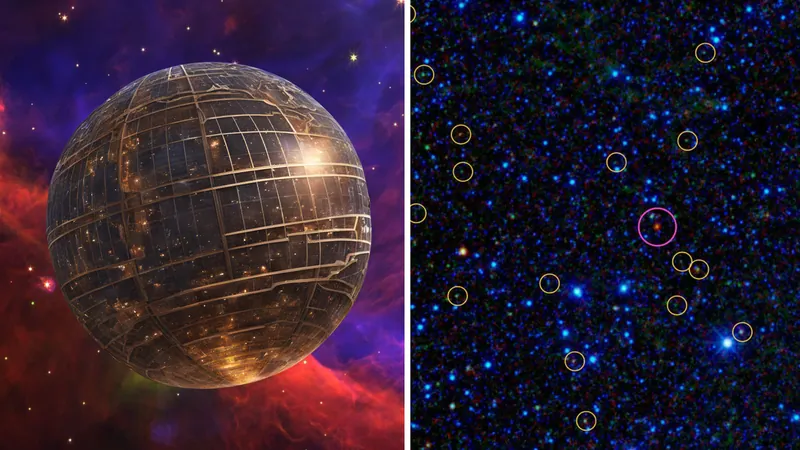
Did NASA's WISE Telescope Spot 'Hot DOGs' Instead of Alien Dyson Spheres?
2024-10-02
Introduction
Earlier this year, scientists made headlines with the possibility that NASA's Wide-field Infrared Survey Explorer (WISE) had detected signals suggestive of Dyson spheres—hypothetical megastructures built around stars to harness their energy. If true, this could indicate the existence of incredibly advanced civilizations capable of manipulating their planetary systems on an astonishing scale.
Skepticism from the WISE Team
However, British astronomer Andrew Blain, a prominent member of the WISE team—now known as NEOWISE since its renaming in 2013—voiced strong skepticism about these claims. He argues that these signals are more likely related to a class of galaxies nicknamed "Hot DOGs" (Hot Dust-Obscured Galaxies) that feature obscured black holes. According to Blain, the persistent references to Dyson spheres have been both misleading and frustrating for researchers focusing on actual astrophysical data.
Understanding Dyson Spheres
A Dyson sphere, initially proposed by physicist Freeman Dyson in 1960, represents a theoretical advancement in energy consumption, suggesting that civilizations could encapsulate their stars to capture energy more efficiently. The overarching idea is that rather than energy being lost to space, it could be harnessed for civilization's needs.
Hot DOGs vs. Dyson Spheres
Blain pointed out some crucial deficiencies in identifying such structures. The characteristics of a Dyson sphere might closely resemble infrared emissions from the Hot DOGs, particularly given the type of data collected by WISE. His criticism gained traction following a publication by Project Hephaistos in May 2024, which reported the detection of seven unusual celestial objects thought to potentially be Dyson spheres. These objects exhibited an infrared signature that deviated notably from standard red dwarf stars, prompting excitement in some circles about the discovery of advanced extraterrestrial technology.
Significance of Hot DOGs
However, Blain warns against these assumptions, highlighting that the conditions for Hot DOG detections align perfectly with the identified signals. Hot DOGs are galaxies cloaked in dust that render them invisible in standard visible light but incredibly bright in infrared wavelengths. The first Hot DOGs were identified in the early 2010s, one of the most notable being WISE J224607.57-052635.0, dubbed the "most luminous galaxy" known at its discovery in 2015.
Potential for Misidentification
With an extensive sky survey of 5 million stars, Blain elucidated the rationale behind the potential misidentification. The close proximity of Hot DOGs to target stars could lead to confusing observations, especially if the former coincidentally lies behind the latter. “Finding seven Hot DOGs within one arcsecond of a star is to be expected,” Blain explained, adding that the obscured galaxy's properties could often mimic a Dyson sphere's infrared signature.
Conclusion
Despite the discouraging revelations regarding Dyson spheres, Blain contends that studying these Hot DOGs may yield valuable insights. Many unresolved questions about their nature remain, and their study could deepen our understanding of these enigmatic entities in the cosmos.
In conclusion, while the notion of discovering Dyson spheres captivates the imagination, Andrew Blain's insights serve as a critical reminder of the complexities of astrophysical observation. Rather than being a reflection of advanced extraterrestrial life, WISE's findings might instead illuminate the mysterious behaviors of these 'Hot DOG' galaxies—definitely not as glamorous as speculative aliens, but intriguing nonetheless. The universe holds secrets that continue to elude us, and every new discovery could shift our perspective on what lies out there in the vast cosmic expanse.



 Brasil (PT)
Brasil (PT)
 Canada (EN)
Canada (EN)
 Chile (ES)
Chile (ES)
 España (ES)
España (ES)
 France (FR)
France (FR)
 Hong Kong (EN)
Hong Kong (EN)
 Italia (IT)
Italia (IT)
 日本 (JA)
日本 (JA)
 Magyarország (HU)
Magyarország (HU)
 Norge (NO)
Norge (NO)
 Polska (PL)
Polska (PL)
 Schweiz (DE)
Schweiz (DE)
 Singapore (EN)
Singapore (EN)
 Sverige (SV)
Sverige (SV)
 Suomi (FI)
Suomi (FI)
 Türkiye (TR)
Türkiye (TR)